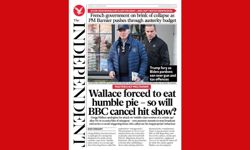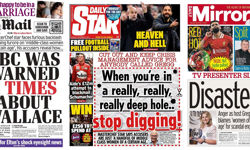
8.50pm, Sunday 8 January 1989: the phone’s ringing at the bar in the Virgins and Castle, the oldest pub in Kenilworth, Warwickshire.
“John! It’s for you,” calls the landlord, and veteran hack John Lamb ambles across the room to take the call, still holding his pint of Mitchells and Butlers Brew XI bitter. What had been a relaxing evening in his local was about to become the busiest night and then the longest week in Lamb’s career.
About half an hour earlier, a Boeing 737 flying from London to Belfast had crashed on to the embankment of the M1 motorway near Kegworth, in Leicestershire, while attempting to make an emergency landing at East Midlands Airport.
The Kegworth air disaster killed 47 of the 126 people aboard and seriously injured another 74. As the news began to break, the London Evening Standard realised that Lamb – one of their sub-editors who commuted from the Midlands every week – was their closest man to the story.
“This was in the days before everyone was carrying mobile phones,” recalls John, “and it was Fleet Street practice for every news desk to have a list of phone numbers for every journalist – including their local pub!”
The Standard’s duty news editor sent him charging up the M1 to the scene of the disaster where what he saw is still clearly imprinted on his mind.
“I remember pulling to the side of the M1, walking up the hard shoulder and there was the back of the plane broken on the side of the motorway,” he says. “I wasn’t supposed to be there, but it was dark and I could see firemen working to release people and bringing out the dead.”
The Standard block-booked several rooms at a hotel near the airport where another four reporters were dispatched to join Lamb. He spent the next three days “without any sleep” running a virtual news desk operation for one of that year’s biggest UK stories.
Now in his 70s, Lamb’s still busy pulling stories together as editor of Chamberlink, the monthly business magazine published by Greater Birmingham Chambers of Commerce, where he also serves as director of press and PR.
And while Kegworth saw him right at the centre of big news, his long career as a journalist has seen him on the edge of numerous other huge stories that came into the newsrooms where he was working.
To name just five: the assassination of Robert Kennedy in 1968; John Lennon shot dead in 1980; the Zeebrugge ferry disaster in 1987; the bombing of Pan Am Flight 103 over Lockerbie in 1988; and the death of Princess Diana in 1997.
Sugar rush
But for his first job, we must wind the clock back more than 50 years to the mid-1960s – that’s the earliest date he’ll admit to – when as a teenager, he landed a job as a copy boy at the Coventry Evening Telegraph.
“It was thirteen mugs on the hour, every hour,” Lamb remembers. “And woe betide you if you forgot the nine spoons of sugar in black tea that sub-editor Barrie Clarke demanded. I seem to remember he had so much sugar that all his teeth fell out!
“But before long, I was promoted to sports assistant and felt my first thrill of the live story – phoning the mid-afternoon’s racing results over to make the ‘stop press’ columns of the late-night final.”
A lack of exams meant there was no opening for Lamb as a journalist at the Telegraph at that stage. But he got to know Charlie Porter, the paper’s cycling correspondent, who went on to become editor of the Kenilworth Weekly News and offered him a job as a trainee reporter.
Lamb never looked back. After passing his NCTJ qualifications, he became a sub-editor on the Telegraph, soon moving onto sport and up the ranks to deputy sports editor, then crossing the Midlands to a similar role at the Birmingham Evening Mail.
These were the late 1970s when the Mail was selling more than 300,000 copies a night – the biggest circulation outside of London – and had a total of nineteen changing geographical and timed editions a day. He worked alongside many who went on to greater things in London, including the late Ray Matts who ended up as one of the biggest characters in sports journalism on the Daily Mail.
London calling
In the 1980s, Lamb ventured down to the capital himself as deputy sports editor of the now defunct London Evening News. When that paper folded, he bounced around as a regular shifter on the subs desks at the Daily Mirror, News of the World and various Sunday papers, “rewriting piles of copy from all over the world into single sentences that gripped the reader”.
Next came a term as assistant editor back on the Coventry Evening Telegraph before Kelvin MacKenzie – then deputy editor on The Sun – tempted him back to London as assistant night editor in the mid-1980s.
“I had a family in the Midlands and so I turned him down twice,” Lamb says, “but when he said, ‘name your price’, I just couldn’t refuse the position on three times what the Telegraph was paying me.”
In those days on Fleet Street, most reporters spent more time gathering their thoughts in the pub than at their desks. And while as a sub-editor and desk man, Lamb wasn’t among the biggest drinkers, he was out often enough to be able to recall most papers’ favourite haunt.
“The Standard and the Daily Express reporters could be found in the Popinjay; The Daily Mirror in The White Hart – although they called it The Stab; The Sun in The Wine Press; the Daily Telegraph in the Kings and Keys; The London Evening News in The Harrow.”
Lamb’s reminiscing over a tremendous three-course lunch with a chilled bottle of Chablis in the new branch of The Ivy restaurant on Temple Row in Birmingham. It’s my humorous salute to his Fleet Street drinking days, when many a story emerged from journalists who courted celebrities and politicians at The Ivy near London’s Covent Garden.
Lamb qualifies my point: “The Ivy was mainly where editors liked to dine and drink in the 1980s, perhaps with the top columnists, but it wasn’t somewhere the average hack could afford. That said, I was probably eating there a few times as a treat from one editor or another, and it’s great to see it open in Birmingham.”
Lamb’s time on the night desk at The Sun saw him working constant 3pm to 3am shifts, often the busiest times when the paper’s entire content could change because of late breaking news. With his family back in Kenilworth, he was commuting, and this exciting but stretched lifestyle eventually saw him join the Evening Standard, where the hours were a little kinder.
Back to Brum
And then the opportunity came up for him to return to the Midlands as assistant editor on the Birmingham Post in the late 1980s, later heading the company’s business development unit launching magazines and newspapers on behalf of other companies.
Lamb joined Birmingham Chamber of Commerce in 1997 to run its media team. He’s still there 21 years later – not only editing the newsy magazine and handling the Chamber’s press and PR, but also running a daily online newsletter sent to 16,000 addresses every morning.
During that time, Lamb helped revive the Birmingham Press Club – the world’s oldest such institution – where he served as chairman for many years and is now vice-president. And there’s nothing that moves in the business or media world in Britain’s second city and surrounding areas that he doesn’t know about.
Again, Lamb is shy of exactly how long he’s been in the world of journalism, but it’s certainly more than half a century. He’s similarly humble about his achievements.
“I feel it’s a privilege to still be doing it,” he says, as we turn into that day’s longest-staying guests after more wine and then coffee. “And I’m very grateful that I still can. There’s not many I started journalism with who want to or can carry on working, but I’m still enjoying every minute.
“Why? Because I love it. The whole process enthrals me, from spotting a lively story in what can sometimes be quite dry copy, to writing a headline that grabs the reader’s eye.”
This leads Lamb into recalling many favourite headlines, but it was the simplest for the old Coventry Evening Telegraph’s pink sports paper in the early 1970s that brings his biggest chuckle.
“Back then, every football match ended at around 4.40pm, and the pink ’un had to be off-stone at 5.05pm – a tight window for final changes, especially when there was injury time. But in those days, the front page headline sold thousands more papers if it was the right one.
“Coventry City were playing away – I can’t remember where – and it was level pegging well after the 90th minute when their striker Willie Carr scored the winner. It seemed like we had only seconds to change the headline and it had to fit the space we had left.”
Lamb came up with: ‘CARR DRIVES CITY HOME’, a perfect fit and a line that had thousands of readers cheering when they bought their paper that evening. And there was an editor’s slap on the back for Lamb when the circulation figures were confirmed a few days later.
“Writing headlines: that’s what I enjoyed on local, big regional and Fleet Street papers, and it’s what I still relish now at the Chamber,” adds Lamb, as we finally emerge from the restaurant.












